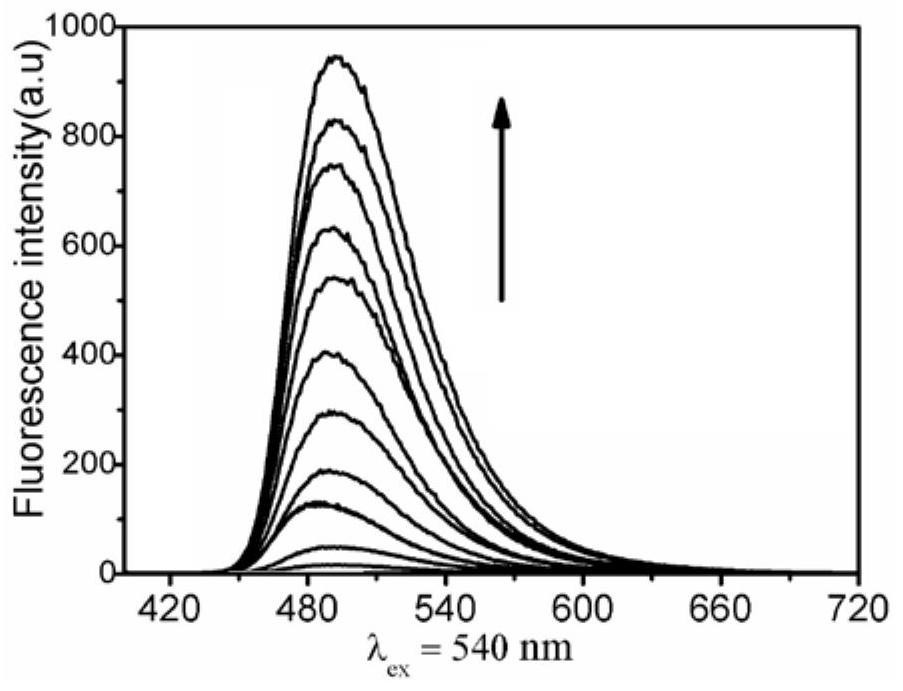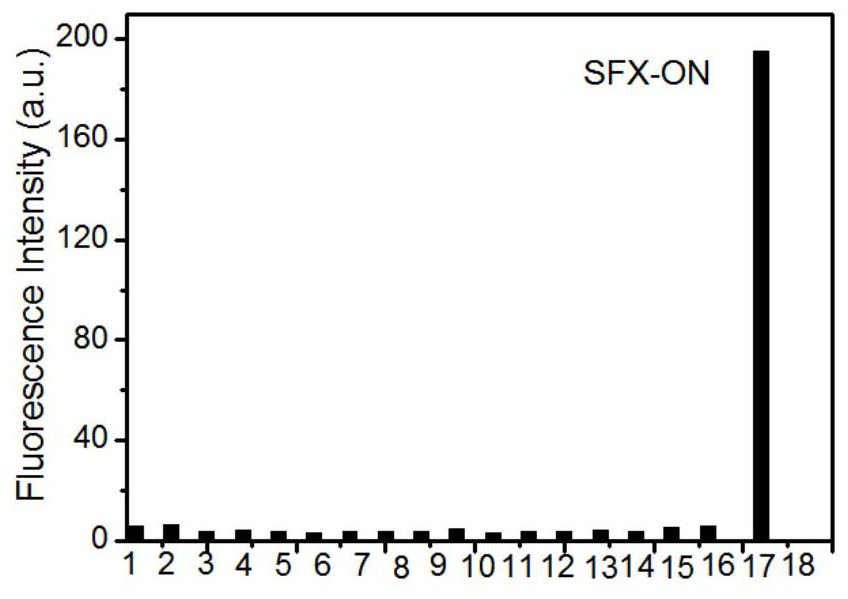AIE type azo enzyme fluorescent small-molecular probe and preparation method thereof
A small molecule probe and azoase technology, applied in the field of fluorescent probes, can solve the problems of single research and lack of application of organic small molecule fluorescent probes, and achieve high luminous efficiency, good fluorescence photostability, and accurate realization. The effect of detection
- Summary
- Abstract
- Description
- Claims
- Application Information
AI Technical Summary
Problems solved by technology
Method used
Image
Examples
Embodiment 1
[0028] step 1
[0029]
[0030] Under nitrogen protection, compound 4,4'-dibromomethylazobenzene 4g (11mmol) was dissolved in 100ml of trimethyl phosphite, then slowly heated to 150°C and incubated for 36 hours, chromatographic detection tracked the reaction progress, the reaction After the end, the reaction solution was poured into 50 ml of petroleum ether, and a large amount of yellow solid was precipitated, which was extracted under reduced pressure, dried, and recrystallized from methanol to obtain a pale yellow solid ON-1, 4.2 g, yield: 90%. 1 H NMR (300MHz, CDCl 3 ): δ8.96-8.93 (d, J=9.0Hz, 4H), 7.36-7.33 (d, J=9.0Hz, 4H), 3.64 (s, 12H), 3.03 (d, 4H).
[0031] Step 2:
[0032]
[0033] Under nitrogen protection, 4,4'-dibromo-4"-formyltriphenylamine (SX-1, 5.0 g, 9.5 mmol), 3,6-di-tert-butyl-9-hydrocarbazole (KZ-1 , 5.8g, 20.9mmol), cuprous iodide (0.72g, 3.78mmol), 1,10-o-phenanthroline (1.5g, 8.3mmol) and potassium carbonate (3.5g, 20.9mmol) mixture was dissolv...
Embodiment 2
[0038] step 1
[0039]
[0040] Under nitrogen protection, compound SX-1 (2.5 g, 5.8 mmol), Pd (PPh 3 ) 4 (0.022g, 0.18mmol), potassium carbonate (0.85g, 8mmol), SF-1 (3.75g, 13mmol) were dissolved in DMF (80ml), heated at 85°C for 12h; after cooling to room temperature, water (100mL) was added , adjust the pH value to weak acidity with 1N hydrochloric acid, the amount of yellow solid precipitation, and dry in a vacuum drying oven at 50 ° C for 24 hours. Then more stringent purification by column chromatography (eluting with dichloromethane / methanol = 9 / 1) gave SFX-1 as a yellow solid, 2.0 g, yield: 90%. 1 H NMR (CDCl 3 ,ppm):δ9.83(s,1H),7.81-7.78(d,2H,J=9.0Hz),7.72-7.70(d,4H,J=6.0Hz),7.54-7.53(d,2H,J =3Hz), 7.49-7.48(d,2H,J=3Hz), 7.36-7.33(q,4H), 7.21-7.13(d,4H), 7.12-7.08(q,4H).
[0041] Step 2
[0042]
reference example 1
[0043] Reference Example 1, Step 3, yielded a yellow solid, yield: 88%. 1 H NMR (300MHz, CDCl 3 ):8.96-8.93(d,J=9.0Hz,4H),δ7.81-7.78(d,4H,J=9.0Hz),7.72-7.70(d,8H,J=6.0Hz),7.54-7.53( d, 4H, J=3Hz), 7.49-7.48 (d, 4H, J=3Hz), 7.36-7.33 (m, 12H), 7.21-7.13 (d, 8H), 7.12-7.08 (q, 8H).
[0044] Example 2:
[0045] step 1:
[0046]
[0047] Under nitrogen protection, add 4-vinylpyridine (1.0mL, 8mmol), compound SX-1 (1.5g, 3.5mmol), palladium acetate (0.0225g, 0.10mmol), three (o-methylphenyl)phosphine (0.06 g, 0.20 mmol) and anhydrous potassium phosphate (0.7 g, 3 mmol) were heated to 120° C. in an oil bath under magnetic stirring for 24 h. After the reaction, the reaction solution was filtered into anhydrous methanol and suction filtered to obtain an orange-red solid, which was dried in vacuo. The crude product was purified by column chromatography with gradient elution to obtain an orange-red solid BEX-1, 2.25 g, with a yield of 2.25 g. 75%. 1 H NMR (CDCl 3 ,300MHz):δ9.8...
PUM
 Login to View More
Login to View More Abstract
Description
Claims
Application Information
 Login to View More
Login to View More - R&D
- Intellectual Property
- Life Sciences
- Materials
- Tech Scout
- Unparalleled Data Quality
- Higher Quality Content
- 60% Fewer Hallucinations
Browse by: Latest US Patents, China's latest patents, Technical Efficacy Thesaurus, Application Domain, Technology Topic, Popular Technical Reports.
© 2025 PatSnap. All rights reserved.Legal|Privacy policy|Modern Slavery Act Transparency Statement|Sitemap|About US| Contact US: help@patsnap.com



